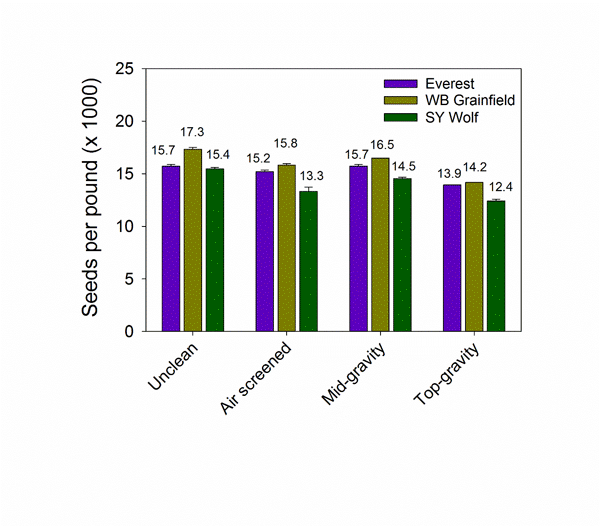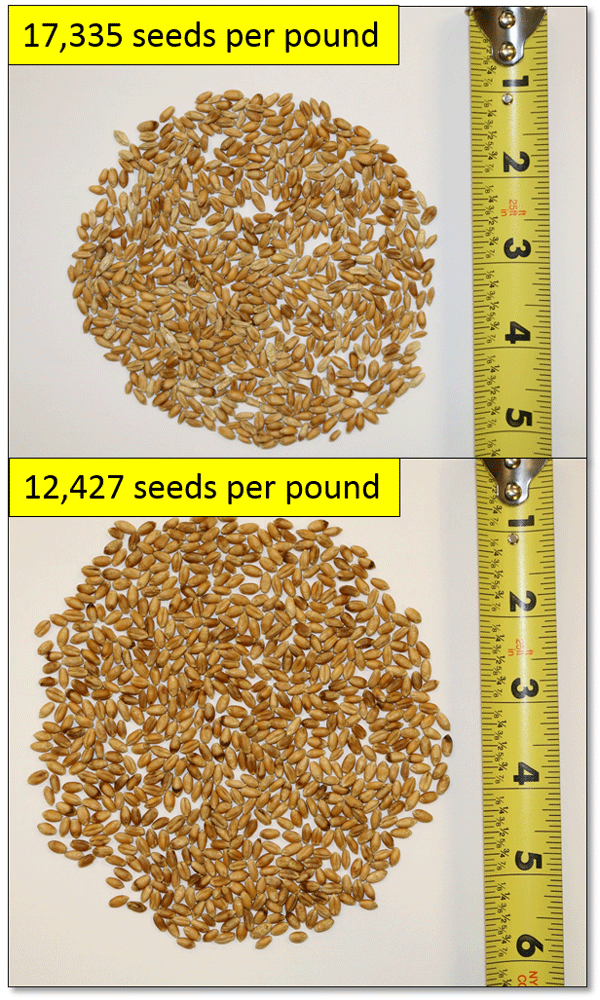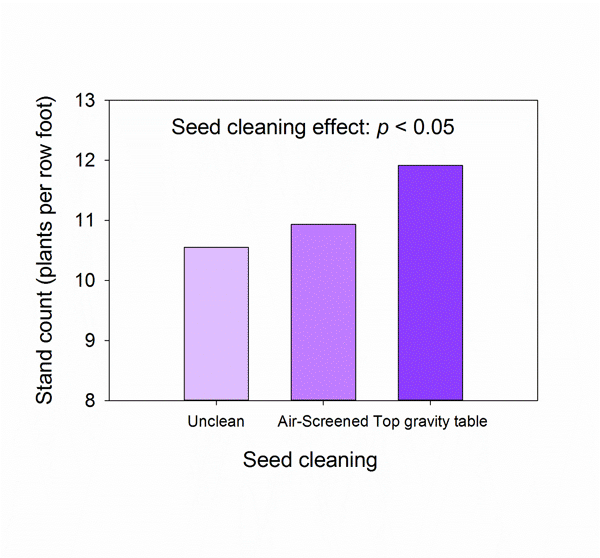Will A Kwik Kleen Clean Seed Wheat Good
By Romulo Lollato, Wheat and Forages Specialist; Lucas Haag, Northwest Area Crops and Soils Specialist
Wheat seeding rate recommendations in Kansas are often stated in terms of pounds of seed per acre, and vary co-ordinate to precipitation zone. However, when planting past pounds per acre, the final number of seeds really planted per acre will depend on seed size. When planting at threescore pounds per acre, for example, a variety with larger kernels will result in fewer seeds planted per acre and possibly thinner stands than a variety with smaller kernels.
If using a seeding rate in terms of pounds per acre and as well few seeds per acre are planted considering of very large seed size, grain yields may be reduced due to the thinner stand if the weather and fertility during the growing flavor are not favorable for autumn tiller formation and survival. Examples of varieties with large kernels include WB4458 and Ruby Lee. Farmers can compensate for this by using a higher seeding rate in terms of pounds per acre with large-seeded varieties (come across Tabular array ane toward the terminate of this article).
On the other extreme, a variety with small kernels can result in higher up-optimal stand up density when planted on a pounds-per-acre basis, increasing plant-to-plant competition for available resources such as water, nutrients and incident solar radiation.
The alternative is to base your seeding rate on number of seeds per acre rather than pounds per acre, to compensate for differences in seed size.
Seed size can exist measured in terms of the number of seeds per pound. The "normal" range is about 14,000-sixteen,000 seeds per pound, but it can range from 10,000 seeds per pound to more than 18,000 seeds per pound. Although seed size is specific to each individual wheat variety, it tin can vary even within a variety depending on seed lot and seed cleaning process.
Effigy ane shows three different wheat varieties. For each variety, seed size is afflicted past seed cleaning. For this uncomplicated study, the varieties Everest, WB-Grainfield, and SY Wolf were evaluated at different times during the seed cleaning process. In Effigy 1:
"Unclean" refers to seed before cleaning
"Air screened" refers to seed remaining after air cleaning or a blower
"Mid gravity" refers to seed from the low end of a gravity table
"Top gravity" refers to seed from the height stop of a gravity table
 Figure i. Furnishings of wheat diversity and seed cleaning on final number of seeds per pound. Seed for this research provided by Ohlde SEeds. Enquiry by Romulo Lollato, Chiliad-State Research and Extension
Figure i. Furnishings of wheat diversity and seed cleaning on final number of seeds per pound. Seed for this research provided by Ohlde SEeds. Enquiry by Romulo Lollato, Chiliad-State Research and Extension
It is clear from Figure 1 that both wheat variety and quality of seed cleaning play a major role in determining wheat kernel size. Overall, the number of seeds per pound decreased (meaning that private seed size increased) as the quality of the seed cleaning process increased.
Figure ii exemplifies the two near contrasting treatments from the above study, the "Unclean" WB-Grainfield (top figure, 17,335 seeds per pound) vs. the "Superlative-gravity" SY Wolf (bottom figure, 12,427 seeds per pound). To accomplish the same number of seeds per acre, "Top-gravity" SY Wolf would require a 39% increase in seeding rate in terms of pounds per acre compared to "Unclean" WB-Grainfield. In other words, if both varieties are planted at a seeding rate of 75 pounds per acre, the final number of seeds planted per acre will exist 1.3 million seeds per acre for "Unclean" WB-Grainfield and 930,000 seeds per acre for "Superlative-gravity" SY Wolf. If the goal was to achieve 1.2 one thousand thousand planted seeds per acre, wheat would be overseeded by nigh 8% for the smaller seed ("Unclean" WB-Grainfield) and underseeded by most 22.5% for the larger seed ("Top-gravity" SY Wolf). This assumes the same emergence charge per unit for the cleaned and uncleaned seed, which would not necessarily be expected.
 Figure 2. Differences in seed size between treatments "Unclean WB-Grainfield (17,335 seeds per pound) and "Top-gravity" SY Wolf (12,427 seeds per pound). Photo past Romulo Lollato, M-Country Research and Extension.
Figure 2. Differences in seed size between treatments "Unclean WB-Grainfield (17,335 seeds per pound) and "Top-gravity" SY Wolf (12,427 seeds per pound). Photo past Romulo Lollato, M-Country Research and Extension.
If planting by seeds per acre instead of pounds per acre, nosotros might run across the opposite results — seed cleaning would really increase stand institution. The seeds in the written report mentioned in a higher place were no-tilled into heavy corn remainder in an experiment during the 2022-16 growing season, with final seeding rate established in seeds per acre. The resulting stand counts are shown in Figure iii.
 Final wheat stand institution as afflicted past seed cleaning process. Plots were sown in seeds per acre. The improved seed quality from the cleaning process increased concluding stand up establishment. Research past Romulo Lollato, K-State Inquiry and Extension.
Final wheat stand institution as afflicted past seed cleaning process. Plots were sown in seeds per acre. The improved seed quality from the cleaning process increased concluding stand up establishment. Research past Romulo Lollato, K-State Inquiry and Extension.
These results indicate that the seed cleaning process increased stand institution. These results were possibly due to improve seed quality, every bit the cleaning process removed modest and shriveled grains that may have lower vigor than larger, healthier ones. Whether planting by seeds per acre or pounds per acre, these results highlight the importance of measuring wheat seed size before planting to avert having the final number of seeds planted per acre too far away from the original target.
Certified seed, or seed submitted for formation testing, will have seeds-per-pound data available. However, an piece of cake on-farm method to estimate the average seed weight of a seed lot is to collect several representative 100-seed samples and weigh each 100-seed sample in grams. To calculate seeds per pound, split the conversion gene 45,360 by the average weight of the 100-seed samples. Samples should be collected from the lot equally is, including large and small kernels in the same proportion as found in the seed lot.
The targeted number of seeds per acre is then divided by the number of seeds per pound to determine the number of pounds to be planted per acre. The following tabular array is a quick reference guide to adjust the planting rate in pounds per acre based on seed size and the targeted number of seeds planted per acre.
How to employ Table 1:
A dryland wheat producer in western Kansas whose target may exist 750,000 seeds per acre has a seed lot with large kernels, averaging 12,000 seeds per pound. Seeding rate in pounds per acre for this seed lot for a last placement of 750,000 seeds per acre should exist about 63 pounds per acre. The same producer, planting a different seed lot with smaller seeds averaging 16,000 seeds per pound, should establish near 47 pounds per acre to attain the same concluding seed placement of 720,000 seeds per acre.
A wheat producer in eastern Kansas whose target may be 1.2 1000000 seeds per acre has two seed lots, the first averaging 14,000 seeds per pound and the second, with slightly smaller kernels, averaging xvi,000 seeds per pound. This producer should utilize a seeding rate of about 86 pounds per acre in the first seed lot and 75 pounds per acre in the second seed lot to attain the same last seed count per acre. In this case, both seed lots were in the "normal" range of about 14,000-16,000 seeds per pound, and a uncomplicated ±10% adjustment on the seeding rate should compensate for differences in seed size.
| Seeds per Pound | Targeted Planting Charge per unit... | ||||
| 600,000 | 750,000 | 900,000 | 1,200,000 | 1,500,000 | |
| Pounds of seed per acre... | |||||
| 10,000 | lx | 75 | ninety | 120 | 150 |
| 12,000 | 50 | 63 | 75 | 100 | 125 |
| 14,000 | 43 | 54 | 64 | 86 | 107 |
| 16,000 | 38 | 47 | 56 | 75 | 94 |
| 18,000 | 33 | 42 | 50 | 67 | 83 |
| 20,000 | 30 | 38 | 45 | 60 | 75 |
Source: https://www.no-tillfarmer.com/articles/6076-evaluating-wheat-seed-size-to-improve-accuracy-of-wheat-seeding-density
Posted by: poeinen1981.blogspot.com


0 Response to "Will A Kwik Kleen Clean Seed Wheat Good"
Post a Comment